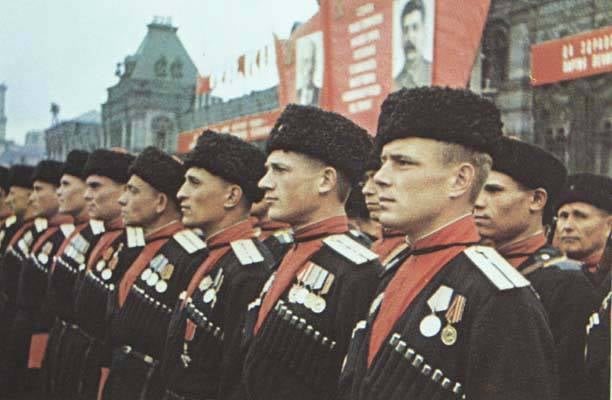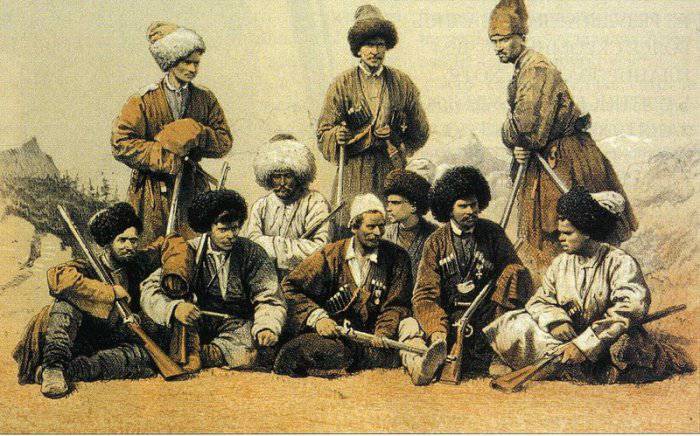History of Russian Special Forces: Reed
Combat use of special forces in contemporary conflicts has become common practice. This is due to the fact that modern combat operations very often require the application of surgically precise and, at the same time, quick and imperceptible strikes, which is the task of special forces. At first glance, special forces are a relatively new concept, peculiar to the character of modern combat operations. However, this is not the case: story domestic special forces has its roots in the distant past, to be more precise - in the era of the origin of the Cossacks in the southern Russian steppes.
The word "plastun" comes from the verb "plastuvaty" - crawl, esp. clinging to the ground. Thus, this word reflects not only the method of imperceptible movement, but also the very principle of conducting operations: imperceptibly for the enemy, merging with the surrounding situation. According to D. Koshkarev, a Cossack researcher, the Zaporozhian Cossacks were still underlain by Dnieper reeds, looking for the enemy and performing small reconnaissance and sabotage operations. Among the 40 Zaporozhye kuren was the so-called Plastunsky, whose Cossacks performed this service.
In the course of the Russian-Turkish war (1787-1791), the combat skills of the plasters reached such a high level that, as a result of this war, the plasters were given the status of a special unit in the Black Sea Cossack army. Divisions of plasters took an active part in the Caucasian War of the XIX century. The main task of the plasters was to prevent the sudden attacks of the Caucasian highlanders on the Cossack villages. To this end, they should conduct constant monitoring of the cordon line of disguised shelters, lie in the "abutments" and "pledges", that is, arrange ambushes for many hours among the marshes and bushes. However, the observation of the ambush was not the main task of the plasters. They also carried out raids on the territory of the enemy, patrolled the banks of the Kuban, exploring the river for the presence of hidden fords and promptly detecting signs of preparation of the enemy to attack. In addition, the scouts struck, to put it in modern language, “pinpoint” strikes against the troops of the highlanders, destroying their leaders, hijacking horses, thereby limiting the enemy's ability to move.
In 1842, the Plastun company from 60 to 90 people were included in the staffing of cavalry and foot units of the Black Sea forces. Plastunov issued more modern weapon. It was the plasters that were the first to get long-range fittings with attached bayonets. Taking into account the specifics of the service, plasters paid higher salaries.
In the event that the enemy was detected during reconnaissance, the plasters almost never gave up. It was considered the rule that the plastun would die better than lose his freedom. Competently choosing a position and having planned in advance the paths of retreat in the event of a chase, the Rehkaluns either fired or merged with the terrain, skillfully using its features. The enemy preferred to avoid a direct collision with a squad of scouts and not to pursue him, since in this case he could easily get into an ambush and suffer senseless losses from well-aimed fire from rejects.
Psychological preparation was an important aspect of plasticity training. Young plasters were taught that in the event of a face-to-face encounter with an adversary, “even the bravest of the highlanders will certainly be a little afraid if there are no witnesses around. Therefore, in such a situation, the mountaineer is hardly willing to decide on a fight with an armed Cossack.
It was impossible to become a rammer just like that, only of one's own will, since there was a whole system of selection. Experienced blooters themselves chose to replenish their team and their future shift among the most trusted and respected warriors. Cossacks tried to take Cossacks from plastonic families so that all combat and hunting tricks were handed down from generation to generation from father to son. Preference was given to middle-aged Cossacks, since it was believed that the young could not be adequately patient and diligent, and the old ones were already heavy on the rise and not fast enough. For the passage of picky selection was not enough one courage and natural prowess, it also required the ability to shoot without a miss, and have excellent physical health and endurance.
Special emphasis was placed on patience and composure, which is explained by the specifics of the work of the plastun. After all, in the ambush they had to lie for hours or sit in the reeds, thorny bushes, and sometimes in icy water or buried in the snow, in no case detecting their presence by an accidental movement.
The manner of action of the plasters of their contemporaries is characterized by the expression “cleft palate and fox tail”, which means cunning, an inconspicuous silent approach and a sudden menacing attack. The main virtues of the plastic arts were the ability to hide their own movements, first to identify the enemy’s whereabouts and ambush him. The Cossacks, who were able to read the “Sakma” (the trace of the enemy), who determined the number of opponents and the trajectory of their movement, enjoyed special respect.
Their own traces, if it was not possible to hide them at all, the plasters carefully entangled, using different techniques for this: they moved backwards, jumped on one leg, in every possible way hiding the direction of their movement and the number of people in the unit.
The participation of plasters in combat operations of different years
Reminders took part not only in combat operations in the Caucasus, their outstanding qualities benefited the Fatherland and other troubled frontiers. During the Crimean War, the Plastonic units successfully participated in the battles near Balaclava and in the legendary defense of Sevastopol. The scouts made forays into the enemy's trenches, and with their intrinsic accuracy, sentry sent the guards silently, destroyed the enemy weapons, and once even captured three enemy mortars to their enemy.
Plastun units were involved in all the Russian-Turkish wars, in the Russian-Persian and Russian-Polish wars, and at the fronts of the First World War there was an 24 of the Plastun battalion. In order to organize the famous Brusilovsky breakthrough in 1916, the 22 battalion of reamers was recruited.
In the Great Patriotic War, several Cossack battalions, regiments, as well as one division were called Plastonic. For their fighting qualities and fearlessness, the fascists called the Rejects "Stalin's thugs." Not only the command of the Soviet army, but also Western military specialists, among whom were emissive officers, had served as advisers in training the US Marine Corps, as well as some special units of the French army, for example, the Foreign Legion .
This begs the question, perhaps now, in order to preserve the traditions, our military leadership should think about assigning the honorary name “Plastun” to special divisions of special forces.
Cossacks in World War II
In 1936, due to the danger of aggression from Germany, restrictions on the service of the Cossacks in the Red Army detachments were lifted. This decision received great support in the Cossack circles, in particular, the Don Cossacks sent the following letter to the Soviet government, published in the newspaper Krasnaya Zvezda on April 24 on April 1936:
Let our Marshals Voroshilov and Budyonny let our cry just click, we will fly together to defend our Motherland ... The Cossack horses are in good body, the blades are sharp, the Don collective-farm Cossacks are ready to fight for the Soviet Motherland with their breasts ...

In accordance with the order of the People's Commissar of Defense K. Ye. Voroshilov N 67 from 23 on April 1936, some cavalry divisions received Cossack status. 15 May 1936 years 10-I Territorial Cavalry North Caucasian division was renamed in 10-th Terek-Stavropol territorial Cossack Division, 12-I Territorial Cavalry Division, headquartered in the Kuban region was renamed in 12-th Kuban territorial Cossack Division, 4-Cavalry Leningrad Red Banner the division named after comrade Voroshilov was renamed 4-th Don Cossack Red Banner Division named after KE Voroshilov, 6-Cavalry Chongar Red Banner named after comrade Budyonny Hovhan in 6-th Kuban-Terek Cossack Division of the Red Banner them. SM Budyonny, on Don, the 13-I Don Cossack Territorial Division was also formed. The Kuban Cossacks served in the 72 Cavalry Division, the 9 Plastun Rifle Division, the 17 Cossack Cavalry Corps (later renamed 4 Guards Kuban Cavalry Corps); 11-th Guards Rovno Order of Lenin, the Order of Suvorov Cossack Cavalry Division and the Cossack militia division in the city of Chelyabinsk. Cossacks who had previously served in the White Army (as, for example, KI Nedorubov [89]) or related to repressed and unreliable individuals were sometimes included in the squad. A special act was restored wearing the previously banned Cossack form [8]. The Cossack units were commanded by N. Ya. Kirichenko, A. G. Selivanov, I. A. Pliev, S. I. Gorshkov, M. F. Maleev, I. V. Tutarinov, Ya. S. Sharaburko, P. Ya. Strepukhov , V.S. Golovskoy, F.V. Kamkov, M.I. Surzhikov and other military leaders of both Cossack and non-Kazakh origin.
2 August 1942 near the village of Kuschevskaya 17 th cavalry corps of General N. Ya. Kirichenko as part of 12 th and 13 th Kuban, 15 th and 116 th Don Cossack divisions stopped the attack of the Wehrmacht major forces advancing from Rostov on the Red Army. . The Cossacks were killed before 1800 soldiers and officers were captured by 300 people, 18 guns and 25 mortars captured.
On Don, a Cossack hundred from the village of Berezovsky under the command of 52-year-old Cossack, senior lieutenant KI Nedorubov in the battle of Kushchevskaya 2 on August 1942, in hand-to-hand combat, destroyed over 200 Wehrmacht soldiers, of whom 70 was destroyed by KI Nedorubov, who found title of Hero of the Soviet Union.
In most cases, the newly formed Cossack units, volunteer Cossack hundreds were poorly armed, and Cossacks with edged weapons and collective farm horses usually came to the detachments. Artillery, Tanks, anti-tank and anti-aircraft weapons, communications units and sappers in the troops, as a rule, were absent, and therefore the troops suffered huge losses. For example, as mentioned in the leaflets of the Kuban Cossacks, “they jumped from the saddles to the armor of tanks, covered the inspection slits with cloaks and overcoats, set fire to cars with Molotov cocktails”
Since 1943, the Cossack cavalry divisions and tank units merged, in connection with which horse-mechanized groups were formed. Horses were used to a greater extent to organize the rapid movement, in battle the Cossacks were used as infantry. Plastun divisions were also formed from the Kuban and Terek Cossacks. From among the Cossacks, 262 cavalrymen were awarded the title Hero of the Soviet Union, 7 cavalcourses and 17 cavalry divisions received guards titles.

Information